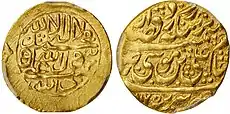Fath-Ali Khan Afshar
Fath-Ali Khan Afshar (17?-July 1764) was an Afsharid chieftain that controlled the Urmia Khanate in northern Iran from 1747 to 1763.
| Fath-Ali Khan Afshar | |
|---|---|
| Khan of Urmia | |
 | |
| Reign | 1747 – 1763 |
| Successor | Mehdi Khan Qasimlu-Afshar |
| Died | Isfahan |
| Dynasty | Urmia Khanate |
| Religion | Islam |
Reign
Early conquests

After Nader Shah's death in 1747, the Caucasus provinces in Iran divided into several dozen principalities known as the Khanates of the Caucasus. Shortly after coming to power, he captured Tabriz and soon consolidated his control over many areas of Iranian Azerbaijan.
Alliance with the Afghans
He soon joined the Afghan warlord Azad Khan Afghan, who gained control of Azerbaijan in the aftermath of the civil war between Ebrahim Afshar and Shahrokh Afshar in 1749.
Participation in the Invasions of Iran
During Azad's invasions of Iran, In March 1754 he dispatched Fath-Ali to battle against Karim Khan Zand.[1] In September 1754, Azad Khan captured Shiraz. In October, Fath-Ali attacked the Zands at Kazerun and defeated them. However, shortly after, the leader of Khesht, Rustam Khan, ambushed Fath-Ali at Kamarij, who retreated to Shiraz.[1] 10 days after they arrived in Shiraz, Azad Khan evacuated the city, making way for the Zand troops to enter On November 29. The Zands gradually cleared Azad Khan Afghan out of Iran and back into Azerbaijan.
Attack of the Qajars
After being pushed out of Iran, the Qajars invaded Azad Khan Afghan's territory under the leadership of Mohammad Hasan Khan Qajar. In November 1755, Afghan forces suffered a serious defeat at the hands of the Qajars, forcing the warlord to leave for Kashan. The Zand, taking advantage of that, captured Isfahan on December 17. Under this pressure, Azad retreated to Urmia. For the next couple of months, Mohammad Hasan and Karim Khan fought each other, giving Azad and his allies time to recover from their defeat.
Deserting the Afghans

After the Qajars inflicted several defeats on the Zand, captured much of Iran's interior (including Isfahan) and marched on Shiraz in June 1756. However, he had to retreat due to Azad's invasion and Azad was able to capture Isfahan in August. Mohammad Hasan fled but blocked the Alburz passes. Azad advanced to Rasht but was defeated at Rudsar and evacuated Rasht in February 1757. The Qajars marched through Talysh and besieged Urmia in April. The Afghans evacuated Isfahan on the 15th to go combat the siege. His army, swelled by Kurdish tribal forces, reached 130,000 in numbers and in June met the Qajars a short distance away from Urmia. Despite numerical superiority he was soundly crushed, thanks to the effectiveness of Qajar cannons [1] and due to desertions by disaffected tribal leaders like Shahbaz Khan Donboli.[2]
Invasion by the Zands
After the fall of Urmia, he was captured and executed in July 1764.[3]
Legacy
Fath-Ali Khan was different from his former ally Azad in many ways. Firstly, Azad was an admirable person and respected even by his enemies.[2] Fath-Ali had a history of treachery and oppression. He made many enemies, and some of those ex-minions were most likely responsible for his execution and spoke of how they detested him even afterwards.
References
- www.amazon.com https://www.amazon.com/Iran-War-1500-1988-General-Military/dp/1846034914. Retrieved 2020-11-24. Missing or empty
|title=(help) - PERRY, JOHN R. (2006). KARIM KHAN ZAND. Library Genesis. OXFORD ONEWORLD. ISBN 978-1-85168-435-9.
- "KARIM KHAN ZAND". iranicaonline.org. Retrieved 11 November 2015.
| Preceded by |
Khan of Urmia 1747—1763 |
Succeeded by Mehdi Khan Qasimlu-Afshar |